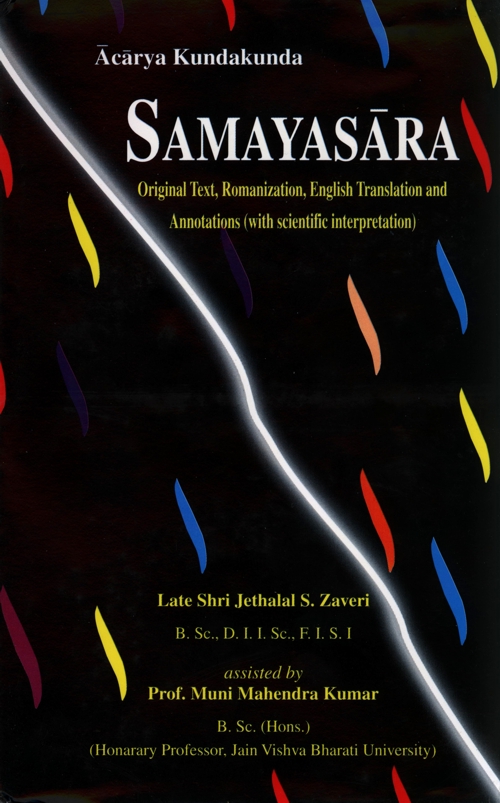
jīvo carittadaṃsaṇaṇāṇatthido taṃ hi sasamayaṃ jāṇa,
poggalakammupadesatthidaṃ ca taṃ jāṇa parasamayaṃ.. 2
(Taṃ Jīvo) That soul which (caritta-daṃsaṇa-nāṇa-ṭṭhido) is totally absorbed in pure darśana [faith] jñāna [knowledge] and cāritra [conduct] is (hi) for sure, (jāṇe) to be known as (sasamayaṃ) the pure self (ca) while (taṃ) that one which (poggala-kamma-padesaṭṭhidaṃ) is engrossed in material karmapradeśa (jāṇa) must be known as (parsamayaṃ) impure self.
Annotations:
The chapter commences with a categorical definition of the self and the non-self by specifying respective characteristics of each.
Jīva is a real substance which is the nucleus of Jain philosophy and its characteristic-unalienable attribute is cetanā or consciousness. Thus consciousness and jīva are eternally coextensive. Hence consciousness is to be posited even in the lowest class of organisms, such as plants, which possess only one sense-organ, viz., that of touch (which includes pain). Pudgala or matter - physical order of existence is devoid of cetanā, and is characterized by taste, colour etc. and thus can be apprehended by sense perception. Both jīva and pudgala are eternal substances.
Every living organism is an organic unity of these two antithetic elements—Jīva and Pudgala which are empirically known as the soul and the body. An organism is thus an embodied consciousness, Soul, itself, is amūrta (non-corporeal) and arūpī (non-imperceptible), whereas body has opposite qualities and is mūrta and rūpī. And thus crops up the complex problem of the relation between the two.
The complex problem is more confounded because the term 'body', again, implies not one but two things:
- The gross physical body which is made up of a head, a trunk, limbs and various organs constituting different systems, It is maintained by the intake of air and food. Death means separation of the soul from this body;
- Besides this gross body there are also two subtle bodies or microbodies known as:
- kārmaṇa śarīra which is constituted by extremely fine matter-molecules known as kārmaṇa vargaṇā,
- the second microbody is taijasa śarīra-the bioelectrical body responsible for vitality in the living beings.
Both the microbodies are an inalienable appendage of the soul and are transcended only by emancipation.
In actual life, consciousness has threefold functions and manifests itself in three ways:
- Knowledge (jñāna) which is a cognitive element,
- World-view or faith (darśana), and
- Conduct or behaviour (cāritra) which is a conative element.
The division of consciousness is expressed in another way also, viz.,-
- Karma-cetanā-indulgence in action and
- Karmaphala-cetanā-indulgence in the fruit of action i.e. pleasure and pain.
In its worldly existence, the soul is associated with various kinds of karma which obstruct the various innate capabilities of the soul and keep it tied to the cycle of rebirths. The worldly existence is a defilement of the pure state and degradation from the supreme level of consciousness. However, there, positively, is a pure and perfect state which the soul has failed to reach/attain as yet but the realization of which is the ultimate goal and object of the spiritual discipline. Primarily the soul itself is responsible for its defilement and degradation and the primal and most fundamental condition of its worldly existence, punctuated with birth and death in unbroken succession, is delusion or perverse belief that consists in mistaking the non-self for the self. Thus, if the soul has to realize itself, it must first recognize the respective characteristics of the pure self and the defiling non-self.
Now the trinity-right faith (darśana), right knowledge (jñāna) and right conduct (cāritra)-is not only the characteristics of the soul, but also the fundamental factors of spiritual progress towards emancipation. This (opening) verse, therefore, determines the direction of the spiritual progress. It states that whenever the soul indulges in identifying the defiling substance-pudgala as the real self, it is going away from its goal and object. On the other hand whenever it is absorbed in its own innate qualities-the holy trinity, it moves nearer towards self-realization.
 Jethalal S. Zaveri
Jethalal S. Zaveri
 Prof. Muni Mahendra Kumar
Prof. Muni Mahendra Kumar

